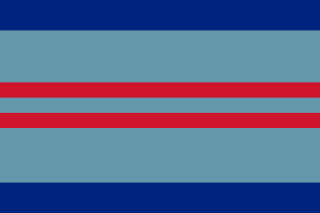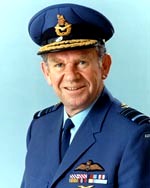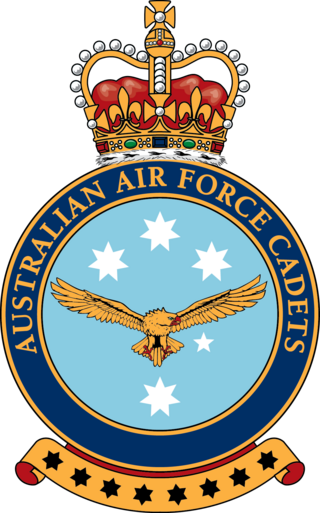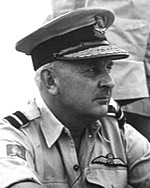Related Research Articles

Air vice-marshal (AVM) is a two-star air officer rank which originated in and continues to be used by the Royal Air Force. The rank is also used by the air forces of many countries which have historical British influence and it is sometimes used as the English translation of an equivalent rank in countries which have a non-English air force-specific rank structure.
Air marshal is an air-officer rank which originated within the Royal Air Force. The rank is used by the air forces of many countries which have historical British influence, including many Commonwealth nations. The rank is usually equivalent to a vice admiral or a lieutenant general.

Air Marshal Sir James Anthony Rowland, was a senior commander in the Royal Australian Air Force (RAAF), serving as Chief of the Air Staff (CAS) from 1975 to 1979. He held office as Governor of New South Wales from 1981 to 1989, and was Chancellor of the University of Sydney from 1990 to 1991.

Chief of Air Force (CAF) is the most senior appointment in the Royal Australian Air Force (RAAF), responsible to the Chief of the Defence Force (CDF) and the Secretary of the Department of Defence. The rank associated with the position is air marshal (three-star). The role encompasses "the delivery of aerospace capability, enhancing the Air Force's reputation and positioning the Air Force for the future". It does not include direction of air operations, which is the purview of the Air Commander Australia, a two-star position responsible directly to CDF in such circumstances but nominally reporting to CAF.

The Australian Air Force Cadets (AAFC), known as the Air Training Corps (AIRTC) until 2001, is a Federal Government funded youth organisation. The parent force of the AAFC is the Royal Australian Air Force (RAAF). Along with the Australian Army Cadets (AAC) and the Australian Navy Cadets (ANC), it is part of the Australian Defence Force Cadets.

Air Chief Marshal Sir Frederick Rudolph William Scherger, was a senior commander in the Royal Australian Air Force (RAAF). He served as Chief of the Air Staff, the RAAF's highest-ranking position, from 1957 until 1961, and as Chairman of the Chiefs of Staff Committee, forerunner of the role of Australia's Chief of the Defence Force, from 1961 until 1966. He was the first RAAF officer to hold the rank of air chief marshal.

Air Chief Marshal Sir Neville Patrick McNamara, was a senior commander of the Royal Australian Air Force (RAAF). He served as Chief of the Air Staff (CAS), the RAAF's highest-ranking position, from 1979 until 1982, and as Chief of the Defence Force Staff (CDFS), Australia's top military role at the time, from 1982 until 1984. He was the second RAAF officer to hold the rank of air chief marshal.

Air Marshal Sir Valston Eldridge Hancock, was a senior commander in the Royal Australian Air Force (RAAF). He served as Chief of the Air Staff from 1961 to 1965. A graduate of the Royal Military College, Duntroon, Hancock transferred from the Army to the RAAF in 1929 and qualified as a pilot. His administrative training at Duntroon saw him mainly occupy staff posts, including Deputy Director of Operations and Intelligence at RAAF Headquarters from 1931 to 1935, and Director of Works and Buildings from 1937 to 1939. During the early years of World War II, he commanded No. 1 Bombing and Gunnery School, and held senior planning and administrative positions. He eventually saw combat in the Aitape–Wewak campaign of the Pacific War during 1945. Flying Bristol Beaufort light bombers, he led first No. 100 Squadron, and later No. 71 Wing. His actions earned him the Distinguished Flying Cross.

Air Marshal Sir Colin Thomas Hannah, was a senior commander in the Royal Australian Air Force (RAAF) and a Governor of Queensland. Born in Western Australia, he was a member of the Militia before joining the RAAF in 1935. After graduating as a pilot, Hannah served in Nos. 22 and 23 Squadrons from 1936 to 1939. During the early years of World War II, he was the RAAF's Deputy Director of Armament. He then saw action in the South West Pacific as commander of No. 6 Squadron and, later, No. 71 Wing, operating Bristol Beaufort bombers. By 1944, he had risen to the rank of group captain, and at the end of the war was in charge of Western Area Command in Perth.

Air Chief Marshal Mark Donald Binskin, is a former senior officer in the Royal Australian Air Force. He served as Chief of Air Force (2008–11), Vice Chief of the Defence Force (2011–14), and Chief of the Defence Force from June 2014 until his retirement in July 2018. In February 2020 he was appointed as a Commissioner and Chairman of the Royal Commission into National Natural Disaster Arrangements. He is the current chair of the Civil Aviation Safety Authority of Australia.

Air Vice Marshal Ellis Charles Wackett, CB, CBE was a senior commander in the Royal Australian Air Force (RAAF). Its chief engineer from 1935 to 1959, he served on the RAAF's controlling body, the Air Board, for a record seventeen years, and has been credited with infusing operations with new standards of airworthiness. Commencing his service career as a Royal Australian Navy cadet during World War I, Wackett transferred to the Air Force in 1923 while on an engineering course in Britain. He qualified as a pilot before completing his studies and returning to Australia, where he inaugurated parachute instruction within the RAAF and made the country's first freefall descent from a military aircraft in 1926. The following year, he led a three-month survey flight to Papua New Guinea.

Air Vice-Marshal George John William Mackinolty, OBE was a senior commander in the Royal Australian Air Force (RAAF). Commencing his service in the Australian Flying Corps (AFC) as a mechanic during World War I, he rose to become the RAAF's chief logistics officer for more than twenty years. Mackinolty was born in Victoria and joined the AFC in 1914. He first saw active duty the following year in the Middle East with No. 30 Squadron Royal Flying Corps. In 1916 he was mentioned in despatches and posted to No. 2 Squadron AFC. By the end of the war he had been commissioned a second lieutenant.
Air Marshal Raymond George (Ray) Funnell, is a retired senior commander of the Royal Australian Air Force (RAAF). He served as Chief of the Air Staff (CAS) from 1987 until 1992. A graduate of RAAF College, he began his career flying CAC Sabre jet fighters in Australia and South East Asia in the 1950s and 1960s. From 1972 to 1975 he commanded No. 6 Squadron, during which time the General Dynamics F-111C swing-wing bomber entered Australian service. He held senior staff posts in the early 1980s. In 1986, he was promoted to air marshal and became the inaugural Vice Chief of the Defence Force. Appointed CAS in July 1987, Funnell was closely involved in the development and dissemination of air power doctrine. He retired from the RAAF in October 1992 following his term as CAS, and was founding Principal of the Australian College of Defence and Strategic Studies from 1994 to 1998. Since then he has served on various Federal Government committees on immigration and detention.

Air Vice Marshal Alan Moorehouse Charlesworth, CBE, AFC was a senior commander in the Royal Australian Air Force (RAAF). Born in Tasmania, he graduated from the Royal Military College, Duntroon, and served with the 2nd Light Horse Regiment in Queensland before transferring to the Air Force in 1925. Most of his pre-war flying career was spent with No. 1 Squadron at RAAF Station Laverton, Victoria. In 1932 he undertook a series of survey flights around Australia, earning the Air Force Cross. Charlesworth's early wartime commands included No. 2 Squadron at Laverton, and RAAF Station Pearce in Western Australia. Appointed Air Officer Commanding (AOC) Eastern Area in December 1943, he was promoted temporary air commodore the following year and took over as AOC North-Western Area in Darwin, Northern Territory.
Air Vice Marshal Margaret Mary Staib, is a former Chief Executive Officer of Airservices Australia and a former senior officer in the Royal Australian Air Force (RAAF).

Air Vice Marshal William Lloyd Hely, CB, CBE, AFC was a senior commander in the Royal Australian Air Force (RAAF). He graduated from the Royal Military College, Duntroon, in 1930 before transferring to the RAAF as a cadet pilot. Hely came to public attention in 1936–37, first when he crashed on a survey flight in the Northern Territory, and later when he undertook two successful missions to locate missing aircraft in the same vicinity. His rescue efforts earned him the Air Force Cross. After occupying staff positions during the early years of World War II, Hely was appointed Officer Commanding No. 72 Wing in Dutch New Guinea in May 1944. Later that year he formed No. 84 Wing, commanding it during the Bougainville campaign until the end of the Pacific War.
The Queensland University Squadron (QUS) was an active Citizens Air Force (CAF) squadron, being part of the Royal Australian Air Force (RAAF) and tasked with training commissioned officers for the RAAF General Reserve recruited from University of Queensland undergraduates from 1950 to 1973. It trained 600 RAAF commissioned officers over 24 years.
Air Vice Marshal Tracy Lee Smart, is an Australian physician, medical administrator, and a retired senior officer in the Royal Australian Air Force (RAAF). She served as Commander of Joint Health Command and Surgeon General of the Australian Defence Force from December 2015 to December 2019. Smart was the third woman to reach the rank of air vice marshal in the RAAF.
Air Vice Marshal Steven Peter "Zed" Roberton, is a retired senior commander of the Royal Australian Air Force (RAAF). He joined the RAAF in 1989 and trained as a fighter pilot. He has deployed to Iraq, commanded No. 75 Squadron RAAF (2003–06) and No. 82 Wing RAAF (2010–11), and led Air Task Group 630 on operations against the Islamic State of Iraq and the Levant (2014–15). He served as commander Air Combat Group RAAF from 2015 to 2017, Air Commander Australia from 2017 to 2019, and Head Force Design within the Vice Chief of Defence Force Group from June 2019 to February 2022.
References
- ↑ "Hammer, Julie Margaret (1955 - )". The Australian's Register. Australian Women's Archive Project. Retrieved 16 April 2018.
- ↑ Air Vice Marshall Julie Hammer Archived 2008-07-20 at the Wayback Machine Brisbane Girls Grammar School article
- 1 2 3 4 5 6 7 8 9 Defence Media Release PACC 186/03 4 July 2003
- 1 2 3 "Air Vice-Marshal Julie Hammer is UQ's 2003 alumni ace". UQ News. The University of Queensland. 17 September 2003. Retrieved 16 April 2018.
- ↑ Bright Sparcs Biographical entry
- 1 2 3 4 5 Ailie Smith (1 August 2007). "Hammer, Julie Margaret (1955 - )". Biographical entry. Encyclopaedia of Australian Science.
- ↑ "Conspicuous Service Cross (CSC)". It's an Honour. 26 January 1997.
- 1 2 "Air Vice Marshal Julie Margaret Hammer". Who's Who in Australia Online. ConnectWeb. Retrieved 22 June 2016.
- ↑ "Member of the Order of Australia (AM)". It's an Honour. 26 January 2004.
For exceptional service in the fields of electronics engineering in Defence, and military education as the Commandant of the Australian Defence Force Academy.
- 1 2 First female President for Engineers Australia Archived 2008-07-24 at the Wayback Machine
Julie Hammer FIEAust EngExec FTSE FRAeA GAICD – 2008 National President, Engineers Australia, Year of Engineering Leadership, Steering Group Profiles, www.engineersaustralia.org.au - ↑ "auDA Board". .au Domain Administration Limited. 23 December 2010. Archived from the original on 16 June 2011. Retrieved 24 June 2011.
- ↑ Honorary Fellows 2011, pg.14, Engineers Australia Queensland Newsletter, Edition 4, 2011, www.engineersaustralia.org.au